“In Lemberg, the capital of the Austro-Hungarian province of Galicia, a family by the name of Gimpel managed to found a permanent Yiddish theatre that, with a few very brief interruptions, lasted for fifty years up until the outbreak of the Second World War. No Yiddish theatre company anywhere in the world came near to matching this record.
Not only were this tiny theatre’s artistic standards, especially as regards music, exceptionally high, it was also responsible for providing the Yiddish theatre in New York with many of its leading actors, actresses and music directors. In addition, Gimpel’s theatre in Lemberg was at the heart of one of the most remarkable achievements of the early decades of the gramophone industry.”
***
Several years ago, Michael Aylward and Julian Futter compiled a CD containing recordings from Gimpel’s Yiddish Theatre in Lemberg (Lviv / Lwów), drawing from their extensive collections. Their CD marked the initial step in restoring Gimpel’s Theatre to its rightful place in the story of the Yiddish theatre.
Generously, Michael and Julian granted permission for me to share the recordings here, accompanied by detailed descriptions of each song and biographies of the performers.
By sharing these recordings alongside the theater’s history, my aim is to shed more light on this remarkable establishment and inspire further research into its legacy.
We also extend an invitation to Yiddish-speaking visitors to contribute to the deciphering of the song texts.
For a comprehensive history of Gimpel’s Yiddish Theatre and their recorded legacy, please read the following article:
***
- The Recordings
- 1. Pepi Littmann – Judl mit sein Fiedl (Yiddle with His Fiddle)
- 2. Pepi Littmann with Leon Graffe piano – Harbe Schale (A Puzzling Question)
- 3. H. I. Reissmann – Der Badchen (The Wedding Jester)
- 4. Norbert Glimer – Jent di roiti kom, Couplet (Yente the Redhead)
- 5. Lina Karlik and Matthias Thur – Ohne ein Kind (Without a Child)
- 6. Helene Gespass mit Violinbegleitung – Die Woch von Pesach Zeit (Passover Week)
- 7. Helene Gespass – Hot a Jüd a Wabale (A Jew Took a Wife)
- 8. Helene Gespass – Oj Oj Manner (Oy, Oy Men, Men)
- 9. G. Z. Weismann – Freitag auf der Nacht (Friday Evening)
- 10. L. Rosenstein, Violinbegleitung: Oskar Zehngut – Pripichok, Zionistisches National-Lied (The Hearth-Zionist Anthem)
- 11. Julius Guttmann – Kale besingen (Serenading the Bride)
- 12. Julius Guttmann – Hei ti di di, aus “Vaterliebe” (Hei ti di di from “Paternal Love”)
- 13. Julius Guttmann – Hakkofos. Rejoicing with the Law, Procession with scrolls of the Law. A Festival Scene
- 14. Julius Guttman – Hatikwa, Zionistenlied (Zionist Song)
- 15. Leon Kalisch – Dort wo die Zeder, Zionistenlied (Yonder, Where the Cedars)
- 16. Leon Kalisch – Lechaim Brüder (A Toast To Life, Brothers)
- 17. Leon Kalisch and Helene Gespass – Blumale Duet (Duet from “Blumale”)
- 18. Leon Kalisch – Scene auf dem Lemberger Naschmarkt (Scene from the Lemberg ‘Naschmarkt’)
- 19. Leon Kalisch – Druschegeschank auf einer jüd. Hochzeit (Announcement of the Wedding Gifts at a Jewish Wedding)
- 20. Jacob Fuchs – Der Bucher aus der Operette “Bar Kochba” mit Chor mit Violine (The Guy, from the operetta “Bar Kochba” with Chorus and Violin)
- 21. Komisches Terzett – Ein Ueberkerenisch aus “Zwei Tanuem” (Comic Trio – An Upheaval from “Two Betrothals”
- 22. Salcia Weinberg vom poln. Ensemble “Weinberg” – Die Fiedel (The Fiddle)
- 23. Herr Schilling – Chave, aus “Jud in Rumänien” (Eve, from “The Jew in Romania”)
- 24. Frau Zwiebel-Goldstein – Sukos lied aus “Tochter Jerusalems” (Sukkot Song from “Daughter of Jerusalem”
- 25. Herr Zuckerberg – Sedernacht aus “Jüdale” (Seder Night from “Jüdale”)
- 26. Sholem Aleichem [Solomon Rabinowitz] – A Joyful Holiday
- The Performers
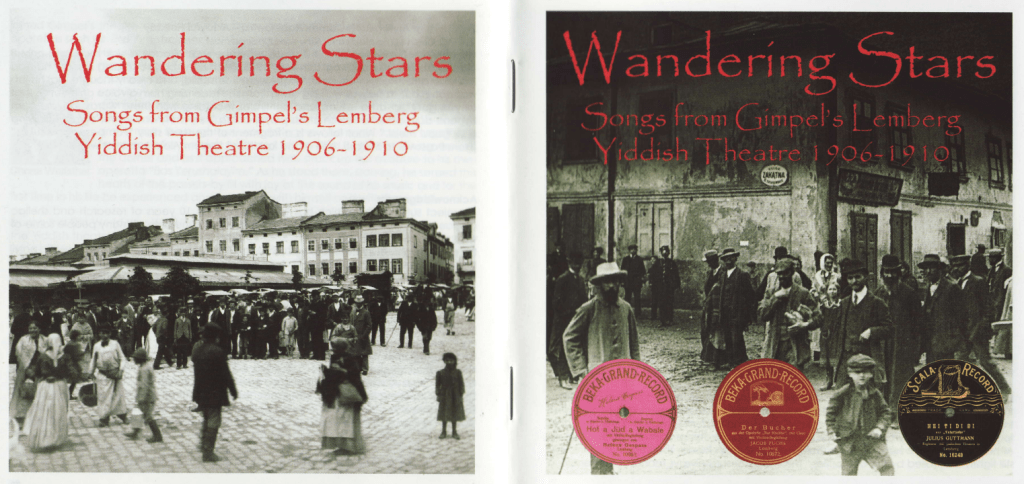
The Recordings
1. Pepi Littmann – Judl mit sein Fiedl (Yiddle with His Fiddle)
Parlophone E3803 (47804), Lemberg, 1907-1910
Long before Molly Picon sang Ellstein’s version of this song in the eponymous film, the theme of the Jew and the violin was a popular and much recorded one.
A little Jew comes to America armed only with his fiddle “Worth more than any amount of money.”
2. Pepi Littmann with Leon Graffe piano – Harbe Schale (A Puzzling Question)
Favorite 1-26123 (5062-o-), Lemberg (probably), 1908 (circa)
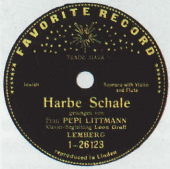
Set to a slightly modified version of the refrain from “Hot a Jud a Wabale” (see track 7), this impassioned song references rich men, poverty, money, factories, and workers. A constantly repeated phrase is: “Just answer me this little question, whether ….” followed by the word “money.” After the war, Pepi Littmann appears to have spent some time in the new socialist Russia and probably her political sympathies leaned in that direction. This, then, may be some kind of early political protest song.
3. H. I. Reissmann – Der Badchen (The Wedding Jester)
Victor 62832-A (4718r), Lemberg, 1908
The Yiddish word “badchen” comes from the Hebrew “badkhan,” meaning jester. The traditional Eastern Europeon Jewish wedding was on elaborate affair that could last up to a week and was composed of many stages, each of which was presided over by a badchen often with the assistance of a group of klezmorim. The role of the badchen, however, was far more than that of jester. He was responsible for providing a more or less impromptu running commentary on the proceedings that was by turns moralising, comic and solemn in tone – all of which had to be delivered in verse.
This recording is a comic depiction of the stage in the wedding ceremony just before the bride is taken to the wedding canopy under which the marriage will be solemnised. At this point it was usual for the badchen to remind the bride of the tragic import of this moment at which the innocence of childhood was about to be exchanged for the heavy duties of married life.
In this particular case, as soon as we are told the name of the groom we know that the poor girl is doomed. He is called ‘Shmendrik,’ a deliberate reference to the odious main character in Goldfoden’s famous comedy ‘Shmendrik oder di komishe khasene’ [Shmendrik or the Comical Wedding]. ‘Cry out for help’, the badchen advises, ‘you must soon go to the wedding canopy, your mother is dead and buried and cannot stand by your side.’ There is much more in this vein, constantly interrupted by cries of ‘Oy vey’ and weeping from the bride’s relatives and friends until a sudden change in mood as the badchen orders the klezmorim to strike up and the scene ends with the violinist playing and the badchen shouting ‘heisser, heisser’ [hotter. hotter].
It might be thought that all this gloom and doom is mostly designed for comic effect, but it should be born in mind that during the period when this kind of marriage ceremony was the norm the bride and groom would not only have been extremely young, but in all likelihood had never even seen each other before the day of the wedding. For many of them the occasion must have been a traumatic event filled with fear, apprehensions and doubt.
4. Norbert Glimer – Jent di roiti kom, Couplet (Yente the Redhead)
Victor 63834-A (12157u), Czernowitz, 1907 or 1908
A riotously ebullient Norbert Glimer sings in praise of the manifold charms of Yente the redhead – ‘Oh what a pretty face she had’, ‘her sweet little feet’.
5. Lina Karlik and Matthias Thur – Ohne ein Kind (Without a Child)
Odeon, Am 8012-B (V.O.1252), Lemberg, 1910-1911
This song is from Jacob Ter’s play ‘Die jüdische Neschume’ [The Jewish Soul] which is set in Galicia and Vienna. A married couple lament that they hove no children around them in their old age: ‘Woe is me . . . her weeping has made the mother blind . . how wretched I am without a child . . who will say kaddish for mother and father.’
The music is by Louis Friedsell and the lyrics by Leon Blank.
6. Helene Gespass mit Violinbegleitung – Die Woch von Pesach Zeit (Passover Week)
Beka-Grand-Record No. 10962, Lemberg, 1907-1908
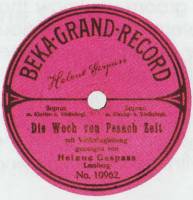
Set to the melody of Shields’ and Evans’ ‘ln the Good Old Summertime’, published in New York 5 or 6 years earlier, this recording is significant on two counts. Firstly, as a classic example of the busy two-way traffic between eastern Europe and the USA in the period before the First World War. Secondly, as a very early indicator of the encroaching influence of Anglo-Saxon popular culture in Europe – at this stage a mere trickle, but set to become a tidal wave from the early 1920s onwards.
The song itself has echoes of ‘Freitag auf der Nacht’. As in the Sabbath, in Passover Week everyone is filled with joy and every Jew is a king. The song is a celebration of the joys of Passover
7. Helene Gespass – Hot a Jüd a Wabale (A Jew Took a Wife)
Beka-Grand-Record No. 10963, Lemberg, 1907-1908, unspecified violinist (possibly Oscar Zehngut)
This riotous tale, narrated at a hectic pace by Helene Gespass who is obviously enjoying every moment of it, deals with the chaotic relationship between a pair of newlyweds. ‘When they married me off’ the husband relates, ‘they laughed and mocked me.’ From what follows it would seem they had reason to. The wife, Sorele, takes all week to make a ‘kugel’ [a kind of casserole that may be sweet or savoury] for the Sabbath eve meal and when the time comes, forgets to take it out of the oven. Her husband flies into a rage and gives her a severe thrashing, whereupon Sorele flees to the ‘mikve’ [ritual bath for women]. Amazingly the husband succeeds in luring Sorele back home, but we are not told how. All we know is that on her return the couple spent the whole night …. Unfortunately, or perhaps fortunately, the crucial word here is impossible to make out on this recording. According to one version of the song the couple spent the whole night having a very long ‘walk.’
This song was especially popular in Hungary and it did in fact originate in the Szatmor region in the of the north east of the country (our thanks to Tibor Csabo Tóth, a researcher at the Holocaust Memorial Center in Budapest, for this information).
8. Helene Gespass – Oj Oj Manner (Oy, Oy Men, Men)
Beka-Grand-Record No. 10963, Lemberg, 1907-1908
The despairing and heartfelt tone in which Helene Gespass sings the title words tells us all we need to know about this song. The name of the violinist is not stated, as is often the case on these recordings, but in all probability it is Oscar Zehngut.
9. G. Z. Weismann – Freitag auf der Nacht (Friday Evening)
Columbia E6123 (7802-o), Warsaw, August 1909
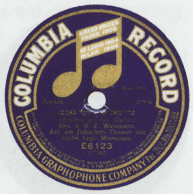
Given Chone Wolfsthal’s reputation as probably the most gifted composer to have worked of Gimpel’s theatre, this CD ought to include some samples of his work. Unfortunately, it did not prove possible to locate a performance by one of Gimpel’s own artists for this particular song, but this performance by the Warsaw based G. Z. Welsmann is very fine.
This song from ‘Moyshele der Mondotor oder der Komischer Boll’ is probably Chone Wolfsthal’s most famous composition and like ‘Pripichok’, also included on this CD, is a good example of a composed song which embeds itself so deeply into the consciousness of the public that eventually its author is forgotten and it attains the status of on anonymous folk song. It has proved impossible so for to establish precisely when Chone Wolfsthal wrote this song, but it would hove been somewhere around the turn of the century. By 1918, however, it is being published in the pages of the German-Jewish monthly ‘Ost und West’ where it is described as a ‘Jewish folk song’ which, remarkably, does not prevent Leo Winz, one of the editors of the journal from inserting ‘Copyright 1918 by Leon Winz, Berlin’ at the foot of the page.
The author of the play from which this song comes was Frieda Eigenfeld who is noteworthy as being one of the few, possibly the only, female Yiddish playwrights of the pre-First World War era. Born in Stanislau, Galicia, she was also the author of the play ‘Fluch der Liebe’ [Curse of Love] for which Chone Wolfsthal also wrote the music.
The song itself conjures up idyllic images of a traditional eastern European Sabbath Eve. The husband of the house returns home from the synagogue on Friday evening to find his pretty little wife has transformed the place into a haven of good cheer. A fine three course meal of fish, noodles and meat is finished off with a nice glass of wine followed by a good night’s sleep.
“On Friday evening,” so goes the refrain, “every Jew is a king, laughter resounds from every corner and the whole house is filled with merriment”
In the final stanza of most versions of this song the mood darkens, dwelling on the troubles and worries that begin all over again with the start of the new week on Sunday. In this version too, mention is made of the labours of the poor.
10. L. Rosenstein, Violinbegleitung: Oskar Zehngut – Pripichok, Zionistisches National-Lied (The Hearth-Zionist Anthem)
Favorite Record (5058-o), Lemberg, 3rd June 1906
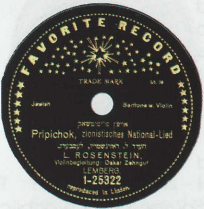
Written by Mark Warshawsky, a lawyer from Kiev, this song soon become regarded as a folk song. This is not surprising, as it was not until 1900 when he was already 52, that Warshawsky, urged to do so by Sholem Aleichem, had his songs published. Up until then he had simply played and sung his songs locally and they had then been disseminated by word of mouth. Together with ‘Rozhinkes mit mandlen’ it is one of the most popular Yiddish songs and as well as many recordings it was used on the soundtrack of the film Shindler’s List.
A fire is burning in the hearth and the room is warm, the ‘rebe’ is teaching little children the ABC. “When you ore older,” he tells them, “you will realise how much sorrow and how many fears lie in these letters.” For some reason the record label describes this homely, sweetly melancholic song as a ‘Zionist Anthem’. The final stanza as printed in the first edition of Warshawsky’s collected songs provides some justification for this, as the ‘rebe’ goes on to explain to the children how in their future lives these letters will give them the strength to bear the exhausting burden of exile. In the version sung here, he urges them to master the alphabet because “happy is he who studies the Torah.”
11. Julius Guttmann – Kale besingen (Serenading the Bride)
Zonophone Twin, Serial 657:T-2389 (3910L), Lemberg, 1906
The scene here is similar to the one depicted in ‘Der Badchen’ (track 3) except in this case the attendant female friends and relatives of the bride ore even more tearful, with some impressively stifled sobbing. Several times the badchen is forced to tell them ‘Hush’ or ‘Ladies, be quiet’ but then proceeds with his doleful musings which only serve to create further outcries while one woman in particular starts to remonstrate forcefully with him. As with ‘Der Badchen’ the scene concludes with a sudden change of mood as the musicians strike up o cheerful tune and all present exit singing on their way to the wedding canopy.
12. Julius Guttmann – Hei ti di di, aus “Vaterliebe” (Hei ti di di from “Paternal Love”)
Scala 16248 (16248), Lemberg, September (circa) 1911
This song is from the play ‘Foter libe’ by Joseph Lateiner which was first staged in 1906, with lyrics and music by Louis Friedsell.
The song dwells on how what you see on the surface bears little resemblance to what goes on in private. Khaim Shmil and his wife bill and coo in public, but when no one is looking they scratch and bite each other. lt’s the same with that elegant young man who tells you his business is just fine and as for the rebe and his hasidim . . . . But whenever you ask ‘How is this possible’ you get the some old answer: “Hei tidi di, hei ti di di . . . Everyone knows . . .Heitididi, heitididi . . . lf no one is watching, nobody sees.’
13. Julius Guttmann – Hakkofos. Rejoicing with the Law, Procession with scrolls of the Law. A Festival Scene
Zonophone Twin, Serial 657:I-2389 (3910L), Lemberg, 1906
Hakkofos is a ceremony that takes places towards the end of the festival of Simchat Torah [Rejoicing in the Law]. The ritual marks the end of the annual cycle of reading through the whole Torah and the start of the new cycle. The Torah scrolls ore token from the Ark and are carried around the synagogue seven times by selected members of the congregation (‘Hakofes’: circuits’), the end of each circuit being accompanied by singing and dancing. Before each circuit commences, the officiant, played here by Julius Guttmann, intones various religious verses in Hebrew. He has his work cut out, however, as a certain member of the congregation is proving to be o bit of a pest, driving Guttmann at one point to cry out ‘avek, avek’ [go away, go away]. He then concludes his recitation and calls for a ‘freylekh’ and the congregation strikes up a joyous melody.
14. Julius Guttman – Hatikwa, Zionistenlied (Zionist Song)
Gramophone Concert V.*4 102468 (10265l) Lemberg, 23 Nov 1909
This is one of the earliest recordings of the Zionist anthem, later the national anthem of the State of Israel. The lyrics ore by Herz Naphtali lmber, a poet from Złoczów, a town 38 miles east of Lemberg. The words sung here ore the first two stanzas and refrain of lmber’s original nine stanza poem ‘Tikvateynu’ [Our Hope] written in 1877. This text was later altered in various ways.
It is noteworthy that both the great Zionist anthems originated in Lemberg or its environs. The origin of the melody is disputed: usually it is attributed to Samuel Cohen from Jassy, Romania who claimed he based the music on a Romanian folk song. Others claim it derives from ‘Fuggi, fuggi, fuggi’ a song by the sixteenth century Italian composer Giuseppino del Biado, to which it bears a striking resemblance. On the other hand such musical resemblances are not uncommon. This recording was made during the same session as the next track.
15. Leon Kalisch – Dort wo die Zeder, Zionistenlied (Yonder, Where the Cedars)
Gramophone Concert V.*4 102467 (10264I) Lemberg, 23 Nov 1909
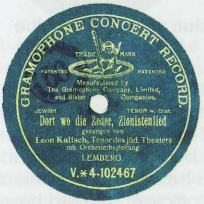
The lyrics for this song were written in 1888 by lsaac Feld, a doctor of jurisprudence in Lemberg. His poem was soon spotted by Cantor Mots from Breslau who set it to music (in the setting on this recording at least its opening bars are eerily reminiscent of the ‘lnternationale’). lt received its first performance at a meeting of the Zion-Verein in Lemberg on 1st February 1890. In its time this was the most popular Zionist anthem after ‘Hatikvah’.
When in 1897 Theodor Herzl left Basel at the conclusion of the First Zionist Congress, he was serenaded by a group of students with ‘Dort wo die Zeder’ rather than with ‘Hatikvah’ which the Congress had just voted to have as its anthem.
Yonder where the slim cedars kiss the clouds
Where the waves of Jordan swiftly flow
Where the ashes of my fathers rest
Where the fields are soaked in the blood of the Maccabees
This fair land by the blue sea’s strand
Was once our fatherland!
16. Leon Kalisch – Lechaim Brüder (A Toast To Life, Brothers)
Victor 63512-B (6053L), Lemberg, 1907
A song in praise of alcohol – text and music by Louis Friedsell.
“What is that is better and sweeter than anything else in the world and worth more than money? lt’s drink good brothers, only drink. Good brandy is priceless, believe me . . . . Lechaim, lechaim [to life, to life]”
17. Leon Kalisch and Helene Gespass – Blumale Duet (Duet from “Blumale”)
Gramophone Record 21171 (528ab), Berlin or Vienna, 6th February 1909
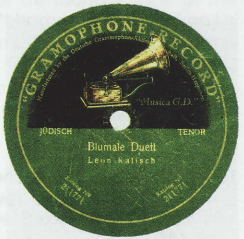
This song, whose normal title is ‘lkh shem mikh’ [I’m Ashamed], is a duet between Zeligel and Tsirele, two characters in Joseph Lateiner’s play ‘Blimele oder di Perele fun Varshe’ [Blimele or the Pearl of Warsaw].
At the start of the song both characters are suffering the torments of teenage hell. Zeligel is in love with Tsirele and doesn’t know how to tell her and, to make matters worse, is concerned that his feelings are shameful. Tsirele is equally agitated because she obviously knows what is going on in his mind and is trying to get him to confess his ardour to her.
“Tell me, tell me,” she cries “don’t be ashamed” but still he dithers. Eventually Tsirele reveals to her anguished admirer what will cure all his ills – a kiss from her. She doesn’t actually say the dread word but hums a kind of kissing sound ‘m m m m m m m m m m.’
Zeligel, somewhat slow on the uptake, does eventually get the message and yells “A kiss, woe is me.” Tsirele, a girl of admirable patience, continues to make kissing noises while Zeligel wails “But it’s a great sin.” “Then I take the sin upon myself,” she cries and the deed is finally done – much, it has to be said, to Zeligel’s instant gratification and delight. Only one artist, Leon Kalisch, is noted on the record label, but we know from the original issue of this record on Zonophone X-104264 that he is partnered here by Helene Gespass.
18. Leon Kalisch – Scene auf dem Lemberger Naschmarkt (Scene from the Lemberg ‘Naschmarkt’)
Gramophone Concert X-2-102589 (6051L), Lemberg, 1907
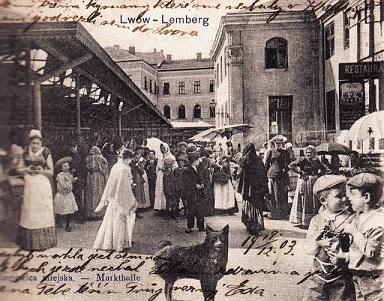
Although he is named on the label, this recording does not star Leon Kalisch. The same ensemble piece with a slightly different text was issued on the Beka label which lists the performers as Julius Guttmann, Norbert Glimer, Jacob Fuchs, Salcia Guttmann, and Lina Karlik.
This extraordinarily atmospheric ‘slice of life’ unfolds in Lemberg’s ‘Naschmarkt’, one of the city’s numerous markets, possibly the main market in the centre commonly known as the ‘Rynek’ or perhaps the smaller market on the Plac Solskich in the heart of the Jewish quarter. Two women start to have an argument which a passer-by attempts to calm down, several ‘characters’ appear, among them various market traders calling out their wares. After much bickering and haggling the scene draws to a close.
19. Leon Kalisch – Druschegeschank auf einer jüd. Hochzeit (Announcement of the Wedding Gifts at a Jewish Wedding)
Victor 63832-B (6080L), Lemberg, 1907
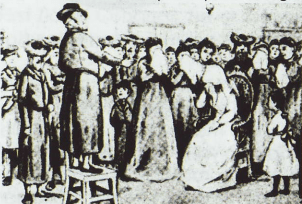
Another wedding scene involving the badchen. The wedding has just token place, the couple are man and wife and the celebrations hove begun. lt is now the job of the badchen, who mounts a chair for this task, not only to announce the wedding gifts but to offer a running commentary on them. To this end he would need to familiarise himself beforehand with the guests. Armed with this information he was able to spice up his commentary with remarks, often quite bitingly satirical, about individual guests, their personal peculiarities and the suitability of their gifts (well-off guests, for example, could expect some pointed comments if their gift did not match the level of their wealth). On this recording Leon Kalisch as the badchen announces a series of wedding gifts from various members of the theatre. some of whose names, such as Emil Gimpel and Herr Schilling, are clearly audible, others less so. Herr Moskowitz from the Cafe Europa is also named. Among the gifts are on automobile, a gramophone with 40 records, 50 dollars (from Sam Schilling) and two other payments in roubles (why these currencies?) This was clearly a prosperous wedding.
20. Jacob Fuchs – Der Bucher aus der Operette “Bar Kochba” mit Chor mit Violine (The Guy, from the operetta “Bar Kochba” with Chorus and Violin)
Beka-Grand-Record, No. 10872 (10872), Lemberg, 1907-1908
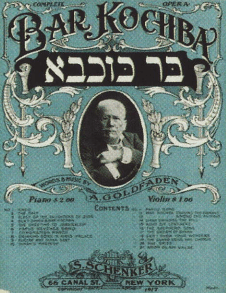
According to the record label this rather strange song is from the operetta ‘Bar Kochba’ (presumably Goldfaden’s ‘Bar Kochba’). However, it cannot be found in any of the printed editions of the work, nor does it appear in any of the sheet music relating to ‘Bar Kochba.’ Either the record label is incorrect or this song was at some stage added to the corpus of songs traditionally belonging to this work. lf the latter, then it never succeeded in establishing itself permanently. Nevertheless, the general mood of the song would suit one of its characters, Papus, the villain of the piece, whose main character trait is his obsession with money and revenge. One of the songs he sings, ‘Di nekome fun Papus’ [The Revenge of Papus], has a laughter passage in the refrain, just as this one does. Also both songs contain references to the blind and crippled. The rather odd and twisted character who sings this song has an interestingly deranged slant on life:
“There’s someone going around dishing out charity and l’ve heard tell how the poor eat and drink their fill at his table and he even shares his money with them! Where can I get hold of such a philanthropist? I’ll sell myself to him with right to title, …. with a [the following words are spat out with such venom they are incomprehensible] and…and… and…and …where is this guy? Where is this fellow? Where is the guy? I want to see him, ha, ha, ha! Come on, come on, let’s see him, I’ll give him what for! Help! Where can I get hold of such a guy?
21. Komisches Terzett – Ein Ueberkerenisch aus “Zwei Tanuem” (Comic Trio – An Upheaval from “Two Betrothals”
Regent Record No. 1274 (1274), Lemberg (probably), circa 1910

The artists are not noted, but this recording was also issued on the Kalliope label and on this release the artists are identified as S. Guttmann. M. Thur and J. Deutsch, i.e. Salcia Guttmann, Matthias Thur and lsaak Deutsch.
This song comes from the play “Di tsvey tnoyim” by Moshe Hurwitz with music by Perlmutter and Wohl and lyrics by Solomon Smulewitz. lt was first staged in New York in March 1902. So far no trace can be found of the text (many of these plays only ever existed in manuscript form and were never printed and published).
22. Salcia Weinberg vom poln. Ensemble “Weinberg” – Die Fiedel (The Fiddle)
Favorite Record 1-26075 (2446-f-), Vienna, 1906
This appears to be some kind of saucy ‘double-entendre’ song in which the fiddle is presented as something that miraculously cures all ills. The chorus starts ‘Di fidl iz zeyer git’ [The fiddle is very good] and there are references to night time and phrases such as ‘Mit zayn vaybshn hat eyner fil shmertsn’ [A man suffers much grief from his wife].
23. Herr Schilling – Chave, aus “Jud in Rumänien” (Eve, from “The Jew in Romania”)
Favorite Record 1-25117 (2536-f-), Lemberg, 23 March 1906 (or thereabouts)
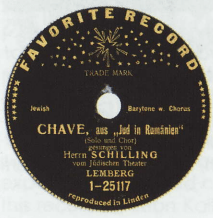
Sam Schilling and the chorus of Gimpel’s theatre perform a song about a mysterious girl called Chave [Eve]. The singer is outraged by her uncouth behaviour, but cannot help wondering what the future holds in store for this ‘wildcat’.
“Ever since God created Eve from Adam, girls called Eve have been a problem – long on hair, short on brains, they expect you to wait on them day and night. I knew an Eve once, big hands, crooked legs, a wildcat from the back of beyond. She could barely get a job as a serving girl. She would drink from the bottle, lick the cups and generally put the whole town in uproar. Chave, oh, Chave, I wonder what will become of you.”
ln the second part of the song (which is not recorded here), we get to hear how things turned out for the girl. Some years later the narrator is out on the street discussing some business deal, when a carriage passes by carrying a pale lady dressed up to the nines like a countess – it’s Chave! How on earth did she manage to become so grand? He asks around and finds out that Chave now runs a magnificent house in town. Listeners may draw their own conclusions as to what kind of house this is.
According to the record label this song is from “Jud in Rumänien”, but is it? This work is by Joseph Lateiner, but Lateiner also wrote a play called “Chave oder die Schlang als Hausfrau” [Eve or the Snake as Housewife] whose title suggests the song might belong to this play instead. To complicate matters further a sheet music edition of the song published in New York in 1905 clearly states the song belongs to the play “Der Antlofener Soldot” [The Deserter]. Although it does not say so, this play is also by Lateiner.
According to this publication the lyrics are by Shmulewitz (aka Solomon Small) and the music by Louis Friedsell. lt is always possible that all three plays mentioned here are one and the same work masquerading under different titles.
24. Frau Zwiebel-Goldstein – Sukos lied aus “Tochter Jerusalems” (Sukkot Song from “Daughter of Jerusalem”
Victor Record 65559-A (11092L), Berlin, 4 August 1910
Although “Tochter Jerusalems” [Daughter of Jerusalem] is a subsidiary title of “Sulamith”, one of Goldfoden’s most famous creations, the work to which this song belongs is lsaak Auerbach’s ‘historical operetta’ of the some name which is more generally known under the title of “Bas Yerushalayim” [Daughter of Jerusalem]. The music is by Chone Wolfsthal who provided the music for several other works by Auerbach. A performance of this play in Berlin in July 1900 received a scathing review from the critic of ‘Das Kleine Journal’ but even this curmudgeon felt obliged to acknowledge the power of Wolfsthal’s melodic invention.
Chone Wolfsthal was born in 1851 or 1853 in Tyśmienica, Galicia, his father was an impoverished cantor. In order to improve their financial situation the family moved to Tarnopol where Chone and his brothers formed the ‘Wolfsthal Brothers Band’ – a virtuoso ensemble with a wide repertoire including non-Jewish music. Wolfsthal received no formal musical education until he was called up into the Austro-Hungarian army where he served in a military band. His career as a composer really took off when in 1890 he joined Gimpel’s theatre as resident conductor and where he wrote a series of classic operettas such as ‘Bas Yerushalayim’.
He was on extremely self-effacing, rather otherworldly individual who found it hard to deal with the practicalities of life. By 1901 he was in financial difficulties and decided to leave Gimpel’s theatre and set up his own travelling troupe. This did not work out and, by his own admission, he ended up wondering the streets of Lemberg starving. He relates how on one occasion as he was making his way down Lemberg’s grand main thoroughfare, wondering how he might scrape together a few pence for a meal, the band of the 30th Regiment swung around the corner and as it approached him, struck up the overture to his own operetta “Bas Yerushalayim.” As he stood there, starving, he sensed the hearts of the passers-by fill with joy at the sound of his music and for the first time in his life he experienced anger – anger with himself and with the world.
During the First World War Wolfsthal left for Vienna where he worked as a conductor in the Yiddish theatre. After the war he returned to Lemberg where he made a meagre living playing at weddings and in coffee-houses. He died in extreme poverty in a lodging house on Lemberg’s Plac Sw. Teodora (better known to Lemberg’s Jews under its Yiddish name of “Kolyn plats” [Koyln plats?]) in December 1924 or January 1925.
25. Herr Zuckerberg – Sedernacht aus “Jüdale” (Seder Night from “Jüdale”)
Gramophone Concert Record G.C.-11596 (714e), Lemberg, June 1904
According to the record label this song is from a play called “Jüdale”. Almost certainly it is not, as there does not appear to be any work of that name. However, in 1906 a certain Herr Rosenstein (probably Abraham Rosenstein from Jassy, Romania) recorded in New York for the United Hebrew Disc and Cylinder Company a performance of this song. On the record label the song is described as coming from the play “Taybele” [Little Dove]. “Taybele” was the name given to the play “Hertsele Meyukhes” [Hertsele the Aristocrat] by Moshe Richter when he took it from Lemberg in 1901 to be performed in Philadelphia and New York. One of the female characters in the play is called Toybele and the cast list also features ‘Seder guests’. The composer and lyricist for this piece is probably Joseph Brody.
26. Sholem Aleichem [Solomon Rabinowitz] – A Joyful Holiday
Victor 60144 (no matrix no.), New York, 7th September 1915
Sholem Aleichem recorded this piece when he was already a sick man and only 8 months before his death on 13th May 1916. At this, his only recording session, he had just recorded “Ven ikh bin Rotshild” [If I were Rothschild] and clearly thought that his job was done; but as he was walking away from the recording horn a voice calls out “ls that all you got?” and he returns and continues recording with these words: “A tale from bygone days about a Jewish chess player and a lively party one winter’s night following a …. good meal.” What follows is a fragment of the short story “Fun pesekh biz sukes” [From Passover to Sukkot], one of the last things Sholem Aleichem ever wrote.
***
The Performers
Pepi Littmann
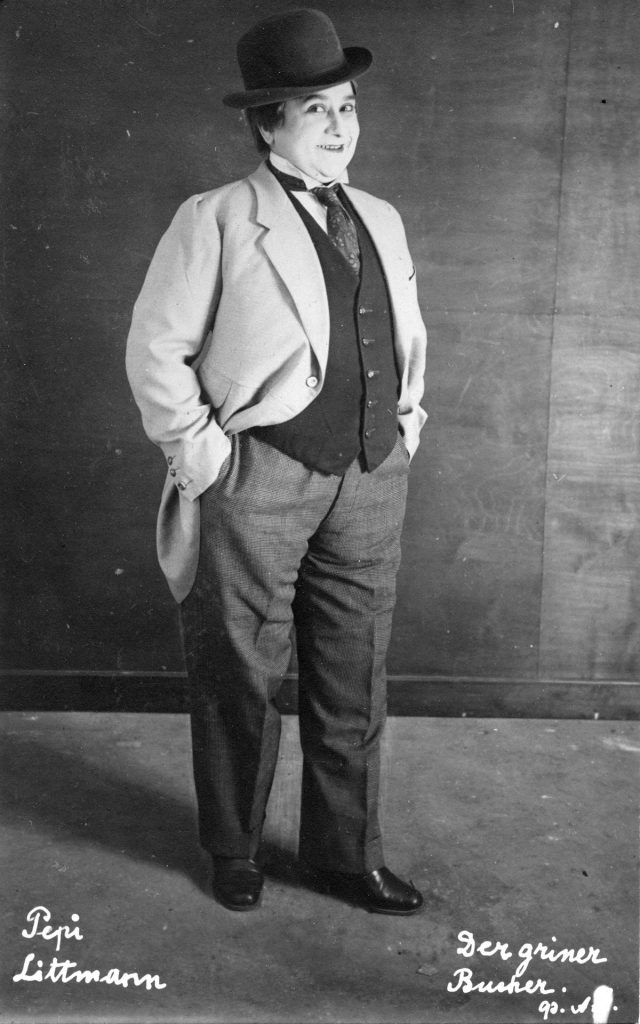
Born Peshe Kahone around 1874 to poor parents in Tarnopol, eastern Galicia (though, intriguingly, in her obituary in the Viennese Jewish newspaper ‘Die Stimme’ she is described as having been born in Lithuania). As a young girl she worked as a maid-servant in the Badin family household, owners of a hotel for actors in Tarnopol and future parents of the actor Max Badin. Eventually she joined a group of Broder singers and with them roamed throughout Galicia and Romania until she met the conductor Yankel Littmann whom she married in Czernowitz and who appears to have recognised her talent, as he began to coach her.
She soon developed her own unique stage act which she performed all over the world. Dressed as a typical eastern European Hasidic ‘yeshive bokher’ [yeshiva student] she would perform a wide variety of songs including many that were highly satirical of Hasidism. In general she tended to perform in more intimate locales better suited to her solo act than the theatre, but she also appeared in dramatic roles onstage from time to time. Of all the much-travelled artists on this discs she was the greatest roamer, appearing not only in Lemberg, which seems to have been her main centre before the First World War, but also in Paris, London, New York, Prague, Karlsbad, Marienbad, Warsaw, Odessa, Vienna, and Budapest (she was especially popular in Hungary). After the Russian Revolution she performed in the Soviet Union. By all accounts she was a charismatic performer who could enthral even those members of the audience who did not understand a word of Yiddish. She died in great poverty in Vienna in 1930.
Jonah Reissmann
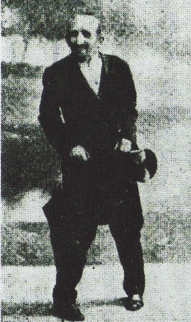
Along with Pepi Littmann, Helene Gespass and Shulim Podzamcze, Jonah Reissmann was considered one of the last of the Broder singers, even though for most of his life his career was spent in Vienna and involved none of the restless wondering typical of the old-style Broder singers.
He was born on 1st January 1862 into a poor family in far-off Kherson, a port in southern Ukraine. By the time he was fourteen he was already involved in the Yiddish theatre, but as conditions for the Yiddish theatre in Russia deteriorated following the assassination of Tsar Alexander ll, he eventually left the country and come to Lemberg. There in 1889 he was taken on by Goldfaden to play the main role in his drama ‘Meshiekhs tsaytn’ [The Age of the Messiah] which he was producing with his troupe of Gimpel’s newly opened theatre. There then followed years of touring interrupted by occasional returns to Lemberg until in 1901 he settled more or less permanently in Vienna where he became one of the leading lights of the Yiddish theatre until his death in November 1932. Like Pepi Littmann he appears to have died in great poverty.
Norbert Glimer
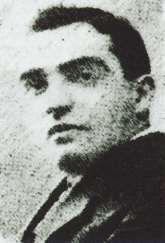
Born 1883 in Lemberg. One of the most popular Yiddish actors in Galicia, he excelled in dramatic character roles and as a reciter.
As well as appearing in Gimpel’s theatre, he had his own theatre troupe and he often performed in Czernowitz. Glimer was one of the first to include in his repertoire the dramas and melodramas of Gordin, Libin and Zolotarevsky, in which he used to act in the main roles. He was married to the actress Stefanie Steif.
He died in September 1926 in Trembowla, Galicia.
Matthias Thur
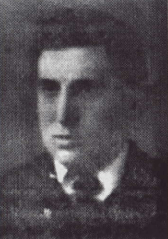
The artist shown on the record label as J. M. Thur must be the actor more commonly referred to as Matthias Thur. Born in the 1880s in Lemberg, his father was a painter and when he was old enough Matthias took up his father’s trade. He was very well-read and extremely fond of the theatre. On one occasion he was given the opportunity to take the part of the socialist in Hurvits’ play ‘Shloyme hamelekh’ [King Solomon] at Gimpel’s theatre and from then he on played supporting parts. In time he proved to be on excellent character actor with a talent for playing ‘father’ roles especially in the Gordin repertoire. He later travelled around with a touring company but eventually returned to Gimpel’s theatre. His diminutive physique prevented him from taking on some of the parts he deserved. He died of cholera on 12th July 1915 in Lemberg.
Lina Karlik
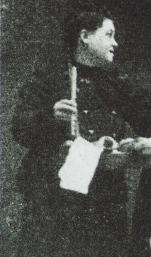
Lina Karlik (also known as Libe Korlik) was born Marjem/Miriam Kichler on 15th March 1875 in Lemberg. Her father worked as on usher in the Yiddish theatre. After finishing secondary school, she worked for a short while in a clothes shop. The chorus-master at Gimpel’s, Yosef Eskreyz, heard her sing and persuaded her parents to let her join the theatre and in 1897 she started as a member of the chorus. After only a few months she was given a character role in the play ‘Di Podriatshik’ [The Contractor] and from then on she continued to play character parts of Gimpel’s theatre in Lemberg – at first juvenile roles and later on more mature parts. She travelled around through Austria, Hungary and Romania and in 1924 (or 1922) celebrated the 25th anniversary of her stage career. During the period 1924-1925 she performed in Argentina and then returned to the stage in Lemberg. She died in 1929.
Her husband Ezriel, as well as performing at the Polish Opera, was also a member of the chorus of Gimpel’s but would regularly sing solo numbers as well. Her daughter, Genia Gelber, was also a Yiddish actress.
Helene Gespass
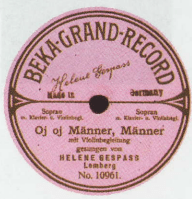
Astonishingly little is known of this tremendously popular actress. Born Henye Gespass around 1886 in Lemberg, she changed her name to Helene and joined the chorus of Gimpel’s theatre in 1904 and sang there for a time as an alto. She then joined the chorus and played small parts at Edelhofer’s Volksorpheum in Vienna and performed in vaudeville with the Weinberg brothers, Pepi Litmann and Carl ltzkowicz in Galicia and Austria. The precise date of her very early death in Galicia is not known, but it can be proved she was recording at least as late as February 1909 (see the ‘Blumale Duett’ on this CD). Her records were obviously a success since the Beka record company produced a special signed label for her records, as they did for two other Gimpel performers, Glimer and Thur. She was the sister of the actresses Frieda Zwiebel-Goldstein and Ella Wallerstein, both of whom emigrated to the USA. Incredibly, for an artist of her stature, there seems to be no surviving images of her.
G. Z. Weismann
It is difficult to be certain who this artist is, but he is probably the actor Gershon Weissmann who for a very short while was married to the actress Regina Kaminska until her untimely death in 1913 at the age of nineteen. He is also likely to be the artist who recorded for the Zonophone label under the name of Hermann Weissmann. Not only are the voices of these two artists identical, their recorded repertoire overlaps and the recordings were made around the same time and in the same place – Warsaw.
lf so there is little that con be said about him, apart from the fact that he was closely linked to the Kaminski troupe and starred in several early Jewish silent films made in Poland – Mirele Efros (1912); Gots Shtrof (1913); Der Umbakanter (1913); Di Shkhite (1913) and Hertsele Meyukhes (1913).
L. Rosenstein
Again it is difficult to be sure who this L. Rosenstein is, but he is almost certainly Leyzer Rosenstein who was born in Jassy, Romania on 22nd January 1881. The whole family was intensely theatrical. His father, amongst several other jobs, worked as an usher in the Romanian theatre and put up posters for the Yiddish theatre. His brothers Samuel and Abraham were both Yiddish actors and emigrated early on to the USA while their younger sister, Rosa, remained in Romania where she joined the Yiddish theatre at an early age and later married the actor-director Maurice Siegler. As well as being an actor, Leyzer was a serious researcher of Yiddish folk songs. Before the First World War he worked as a folk singer in Lemberg for 4 years and also performed alongside Podzamcze, Reissmann and various Gimpel actors.
He eventually emigrated to the USA and for many years worked not only as an actor and director in the Yiddish theatre in Chicago, Minneapolis, Cleveland, New York, Toronto and elsewhere but also as a concert singer performing the Yiddish folk songs he had collected as a young man in Romania. He eventually settled in California where he become on antiques dealer in Los Angeles and where, sadly, he began to lead an increasingly chaotic and troubled life. He died in Los Angeles on 14th January 1960.
Julius Guttmann
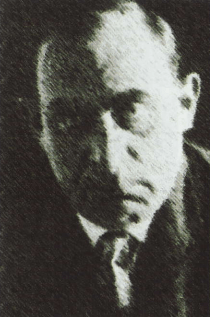
Julius Guttmann was born in Lemberg some time in the early 1870s into a family of bakers. As a teenager he joined a local Zionist organisation where he befriended a number of actors from Gimpel’s theatre and, via their good offices, he joined Gimpel’s theatre in 1891 as a writer and prompter but soon took to the stage himself. From the day he joined the Gimpel troupe right up until the outbreak of the Second World War he was the mainstay of the company both as director and a greatly respected actor. In the opinion of the actor, director and theatre historian, Jonas Turkow, he was the greatest actor of his generation to come from Galicia. Although firmly rooted in Lemberg he, like so many of his fellow actors, toured extensively, performing in Vienna, Budapest, London, Germany and Romania. He died in Lemberg during the war at the hands of the Nazis.
His wife Salcia was also a long-term member of Gimpel’s theatre and his brother Dr. Samuel Guttmann was chief rabbi at Lemberg’s Liberal Temple.
It is a measure of his popularity that between 1906 and 1912 he made nearly 150 gramophone recordings for at least half a dozen different record companies.
Leon Kalisch
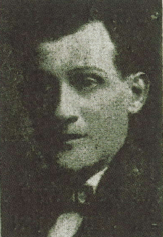
Born on 1st January 1882 in Lemberg into a family of tradesmen, he joined the chorus of Gimpel’s theatre in 1898. but after only a few weeks was spirited away by Chone Wolfsthol’s travelling troupe. He acted with the troupe for four years and then returned to Gimpel’s theatre where, young as he was, he was given singing roles in romantic leads.
In 1903 Kalisch was called up into the army and on returning home married a member of the chorus (possibly Rosa Schreck) who later also became an actress. Kalisch was then taken on by Siegmund Feinman for his theatre in London and from there by a troupe staging Yiddish theatre in Buenos Aires. After performing in Argentina for a year he returned to Lemberg where he continued acting at Gimpel’s theatre and also directing some of the plays. He was without doubt one of the mainstays of Gimpel’s theatre. Offstage he was renowned as a prankster, with the unfortunate Emil Gimpel being the frequent butt of his often very elaborate practical jokes.
There is scant information regarding Kalisch’s activities during the inter-war years, but his son Henry, an actor in the Yiddish theatre who was drafted into the Red Army during the war, relates that by 1939 his father had retired from the theatre but was still performing as a singer. Henry returned to Lemberg in 1944 by which time his whole family had perished. Leon Kalisch and his wife Rosa are said to have died in the ghetto some time between 1942 and 1944. After the war Henry emigrated to the USA and may have been active in the Yiddish theatre there. He also had a sister, Salomea, a Yiddish actress and sinqer about whom at the moment we know nothing.
Jacob Fuchs
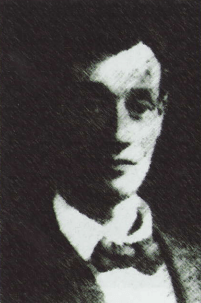
Born in March 1880 in Lemberg, his father was a poor tailor. When he was 17 a friend managed to get him taken on as a member of the chorus in the Yiddish theatre. He soon left to appear onstage in Romania but after a short while returned to Lemberg and started to act in solo parts. He was a very gifted tenor but had to give up singing because of a lung condition. His skill as a character actor equalled his musical talent and he was renowned for his versatility, being just as much at home in the popular theatre as in the more serious ‘artistic’ dramas.
However, his lung condition deteriorated and on 21st February 1921 (or possibly 1920) he died in Lemberg. His wife, Ruzha Fuks, who acted at Gimpel’s theatre for decades, was killed by the Nazis. Their son, Leo Fuchs, emigrated to the USA in the late 1920s where he become one of the greatest stars of the New York Yiddish theatre.
Komisches Terzett
The label on the record used for this CD does not mention the artists in this ‘comic trio.’ Luckily, however, the recording was also issued on the Kalliope label with the same catalogue number and same coupling. On the Kalliope issue the artists are named as Matthias Thur, Salcia Guttmann and lsaak Deutsch.
Salcia Weinberg
Born Sara Licht on 16th October 1878 in Przemyśl, Galicia, the daughter of an artisan. She married the actor Hermann Weinberg when she was only fifteen and in between performing, managed to have 8 children. She started singing in the chorus of the Polish Opera in Lemberg and then joined Gimpel’s theatre. She toured extensively with her husband. visiting Hungary, Bulgaria, Serbia, Slovakia, Germany and, not least, Prague in 1911 where she performed at the Cafe Savoy. In the audience was Franz Kafka upon whom she mode a great impression. Vienna become her main centre of activity and she performed there throughout the 1920s and into the 1930s. ln 1924 she starred in the Austrian silent movie ‘Stadt ohne Juden’ [City Without Jews] and is one of the few artists from the Yiddish stage of this era to have been captured on film. She died in Vienna on 11th December 1940.
Sam Schilling
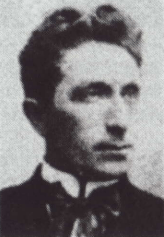
Sam Schilling was born on 13th July 1868 in Stanislau, Galicia. ln 1890 he left home and spent the next 14 years or so touring Eastern and Central Europe with various Yiddish theatre troupes. Some time between 1899 and late 1902 he joined Gimpel’s theatre. During the following years until his death in 1926, he periodically left Lemberg and toured extensively in England, Austria, Romania and Argentina. Although at heart a serious actor he was always regarded by the public as the star comedian at Gimpel’s theatre. In 1910 he married the Yiddish actress Rosa Brüh, whose sister Anna was the wife of the actor Adolf Melzer. Rosa was murdered by the Nazis some time after 1942.
Frieda Zwiebel-Goldstein
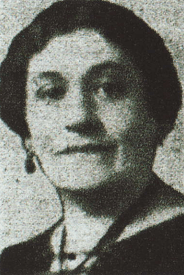
She was born Frieda Gespass, the elder sister of Helene Gespass, on 27th December 1877 in Lemberg. Like so many of the artists of Gimpel’s theatre she started her stage career, aged thirteen, at the Polish Opera in Lemberg where she performed for three years before being taken on at Gimpel’s. Her first role was that of Delilah in ‘Shimsen hagiber’ [Samson the Hero]. That a lead part was assigned to a sixteen-year-old girl is a remarkable achievement and at early sign of the great esteem in which she was to be held throughout her career.
In 1894 the Romanian-born actor Louis Zwiebel came to Lemberg, met Frieda, married her and that same year the couple returned to America where they performed for the next 3 years, returning to Lemberg in 1897. This second visit of Louis Zwiebel’s to Lemberg may well have been one of the most important events in the history of Gimpel’s theatre, as he purportedly brought with him the entire repertoire of the Yiddish theatre in America. Up until this visit of his, these American Yiddish plays were only very rarely performed in Europe. After his visit, they began to play a prominent, possibly dominant, role.
The Zwiebels remained in Europe for some time. Presumably at some stage they divorced, since it is reported that Frieda married the actor Leyzer Goldstein in 1906 while Louis died in Vienna in 1907. After his death, Frieda stayed on for several years acting in Galicia until she was taken to America by Adler. This was likely to have been before the outbreak of the First World War, as she was recording in New York by 1916.
She continued acting in America, her last reported performance being at Elving’s Theatre, New York, in 1926. What happened to her after that has proved impossible to establish which, given her great reputation as one of the ‘grandes domes’ of the Yiddish theatre, is astonishing.
Herr Zuckerberg
The ‘Herr Zuckerberg’ who sings on this recording is Sigmund Zuckerberg, husband of the rather more famous Regina Zuckerberg. Both Sigmund and Regina Zuckerberg barely rate a mention in any history of the Yiddish theatre, Regina only warranting a few words because of her longstanding relationship with the celebrated actor Boris Thomashefsky whose mistress she was for several decades. This is a gross underestimation of the importance of both these artists.
Before they emigrated to America at some as yet unknown time between 1909 and the First World War, they ranked among the top stars of the Yiddish theatre. Their presence on the bill was on absolute guarantee of a full house and on at least one occasion, when Gimpel’s theatre was on the verge of financial collapse, they were rushed back from the provinces where they were on tour with another company and made a series of appearances at Gimpel’s that, as expected, played to packed houses and so saved the day for the theatre.
In Europe both Sigmund and Regina were acknowledged by even the most fastidious critics of the Yiddish theatre as being supremely accomplished singers and actors, yet their careers in the USA appear never to have taken off. All we know at the moment about Sigmund in America is that he starred in George Roland’s 1932 film ‘Yoysef in Mitsraim’ [Joseph in the Land of Egypt]. Whether he actually appears in this film is debatable as it is something of a mish-mash: most of the film consists of on earlier silent film with a later soundtrack added in Yiddish. However, some additional footage was shot which was spliced into the older film, so perhaps he appears there. As a footnote it’s worth mentioning that Joseph Green, the director of Mollie Picon’s “Yidl mitn Fidl”, co-starred in this film and appeared in Gimpel’s theatre in the summer of 1933.
Assuming that the actor whose gravestone can be found in the Yiddish theatre section at Mount Hebron cemetery, Flushing, New York, is the Sigmund Zuckerberg in question here, then he died on 11th August 1946 aged 67.
lsaak Deutsch
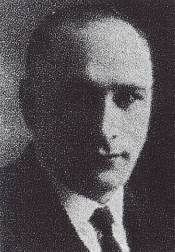
He was born on 18th December 1884 in Tulchin, Ukraine, about 260 miles south-east of Lemberg. His father was a teacher and the family name was actually Solomianki. However, as his father was a ‘maskiil’ (a supporter of the ‘Haskalah’ or Jewish Enlightenment movement that originated in Germany), he was known locally by the surname ‘Deutsch’, a name that young lsaak was to adopt permanently (literally the name means ‘German’ but it was also widely used by Orthodox Jews as a term of disapproval directed at Jews who had in their opinion assimilated too much).
After having attended his father’s school he trained to be a locksmith, soon abandoned this, worked in Odessa in a variety of jobs and finally made off to join his brother who was a cantor in Brody. He had a fine tenor voice and worked under his brother as a ‘meshoyrer’ [choirboy] for ten months, during which he picked up the rudiments of music. He then left Brody and come to Lemberg where he joined the chorus of Gimpel’s theatre and was soon being given small roles to play. He stayed at Gimpel’s for three years, probably from about 1906 to 1909. In 1910 he left for Vienna which was to be his home for the next 15 years and where he co-founded Vienna’s first permanent literary theatre the ‘Freie Jüdische Bühne’. By the mid-1920s it was becoming increasingly difficult for him to sustain his career in Vienna and in 1925 he emigrated to Argentina. There he spent the next ten years of his life acting in Argentina, Brazil, South Africa and, after a brief spell back in Vienna, Argentina once more. He died in São Paulo, Brazil, in 1934.
Leon Graff
Born in 1888 in a village near Jassy, Romania. He attended school and the local conservatory and at 16 left for Vienna where he completed his studies at a commercial college. Thereafter he earned a living accompanying Yiddish folk singers on the piano. He was engaged by the Rabinowitz troupe to go with them on tour in Hungary and on his return to Vienna he was taken on as conductor of the orchestra at the Yiddish theatre. There he remained for 16 years during the course of which he orchestrated many operettas, wrote additional songs for various plays, wrote the music for the play ‘Der shabes-goy’ and also acted a little.
ln 1922 he returned to Romania and for a while worked as conductor for the orchestra in one of Bucharest’s cinemas, but was soon appointed conductor at the Great Synagogue where he remained for 18 years. ln 1950 he emigrated to Israel and became conductor at the Great Synagogue on Allenby Street in Tel Aviv. In Israel, where he died in 1975, he made many recordings as accompanist to various cantors.
Oscar Zehngut
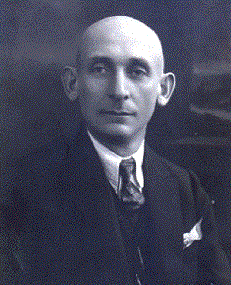
Although several of his recordings have been issued on LP and CD over the last few decodes, no biographical information has ever been found for this artist. However, while researching this CD some information has at last come to light. We still do not know when and where he was born, nor when or where he died, but we do now know that at some time or other he was the music director of Moshe Richter’s, Ber Hart’s and Norbert Glimer’s travelling troupes.
For several years from 1906 on, a new generation of Broder singers such as Pepi Littmann and her husband Yankel, Helene Gespass, Kanapov, Abraham Rosenstein, Jonah Reissmann, Shulim Podzamcze, Moshe Weinberg, Hermann Weinberg and others performed songs, sketches and one-act plays in the restaurant garden of Yasha Hant in Lemberg. The musical accompaniment for these performances (on violin, piano or sometimes a whole quartet of musicians) was directed by Oscar Zehngut. Zehngut’s brother Zygmunt owned one of the biggest hotels in Lemberg, which would suggest that Oscar was probably born into on affluent family. lf he did come from such a wealthy background it is likely that he was a classically trained violinist and most certainly cannot be categorised as a traditional klezmer musician.

